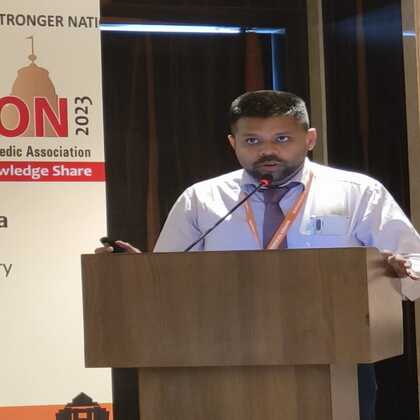Your Ultimate Guide to Preventing and Managing Spinal Spondylosis
Discover how to prevent and manage spinal spondylosis with practical tips on posture, exercise, ergonomics, and treatment options for a pain-free, active life.


Introduction
Does a constant, nagging ache in your neck or lower back sound familiar? You’re not alone. Back and neck pain are among the most common complaints worldwide, and often, the culprit is spondylosis—a fancy term for the wear and tear our spines experience as we age. Think of it as the "gray hair" of your spine; it's a natural process, but how we treat our bodies determines whether it becomes a minor nuisance or a major disruption to our lives. This comprehensive guide is designed to empower you. We'll move beyond just defining the problem and dive into actionable, practical tips to protect your spine from the effects of spondylosis. Whether you're looking to prevent it or manage existing discomfort, you’ll find evidence-based strategies on posture, exercise, ergonomics, and daily habits to build a stronger, healthier back for years to come. Let’s unlock the secrets to a pain-free, active life.
What Exactly is Spondylosis? It's More Than Just "Back Pain"
Spondylosis is not a single disease but a broad term describing degeneration of the spinal discs, facet joints, and bones. As we age, the spinal discs that act as cushions between our vertebrae lose hydration and become thinner. This leads to increased stress on the facet joints and the formation of bony projections called bone spurs (osteophytes). This entire process is a form of osteoarthritis specific to the spine.
Cervical Spondylosis vs. Lumbar Spondylosis: Knowing the Difference
The location of the degeneration defines the type of spondylosis and its symptoms.
Cervical Spondylosis: Occurs in the neck region (cervical spine). It's extremely common, with studies suggesting radiographic evidence of it in over 85% of people over the age of 60. It often causes neck pain, stiffness, and sometimes headaches.
Lumbar Spondylosis: Occurs in the lower back (lumbar spine). This area bears most of the body's weight, making it highly susceptible to degeneration. It primarily causes lower back pain and stiffness.
The Silent Progression: How Spondylosis Develops Over Time
This degeneration doesn't happen overnight. It's a slow, progressive process that often begins silently in your 30s and 40s. You might not feel anything until the changes become significant enough to irritate a nerve or strain the surrounding muscles. Understanding this silent progression is key—it means the preventive steps you take today are investments in your future mobility.
Consult a Specialist for the best advice
Are You at Risk? Key Factors That Contribute to Spine Degeneration
While aging is the primary catalyst, several other factors can accelerate the process of spinal degeneration.
Unavoidable Risks: Age and Genetics
Everyone will experience some degree of spinal wear and tear as they get older. Additionally, genetics can play a role in how quickly your discs degenerate and your predisposition to developing bone spurs.
Lifestyle Risks You Can Control: Your Job, Weight, and Habits
This is where you have the power. Repetitive stress from jobs involving heavy lifting or vibrating machinery is a major risk. A sedentary lifestyle weakens the core muscles that support the spine. Excess body weight, especially around the abdomen, puts constant strain on the lumbar joints. Smoking is a significant but often overlooked risk, as it reduces blood flow to the discs, impairing their ability to absorb nutrients and heal.
Listen to Your Body: Recognising the Symptoms of Spondylosis
Early recognition can lead to earlier management and better outcomes.
Symptoms in the Neck (Cervical Spondylosis)
Stiffness and pain in the neck
Headaches, often originating at the back of the head
A grinding feeling or sound when moving the neck
In more advanced cases, tingling, numbness, or weakness in the shoulders, arms, or hands (signs of nerve compression).
Symptoms in the Lower Back (Lumbar Spondylosis)
Localised ache or stiffness in the lower back, especially in the morning or after periods of inactivity.
Pain that worsens with twisting or lifting.
Rarely, if nerves are compressed, pain, numbness, or weakness can radiate into the buttocks or legs.
When to See a Doctor: Red Flags Not to Ignore
While mild pain can often be managed at home, consult a doctor immediately if you experience:
Loss of bladder or bowel control.
Progressive weakness in your arms or legs.
Severe, unrelenting pain that doesn't improve with rest.
Numbness or tingling that is severe or spreading.
If these symptoms appear, it's crucial to seek professional evaluation. You can consult a specialist online with Apollo24|7 for a prompt assessment and guidance.
Your Daily Armor: Essential Tips to Protect Your Spine
This is your action plan. Integrating these habits can dramatically slow degeneration and manage pain.
Master Your Posture: The Foundation of Spinal Health
Good posture evenly distributes force across your spine, minimising stress on any single part.
Sitting Pretty: Ergonomics at Your Desk
Feet Flat: Keep feet flat on the floor, knees at or slightly below hip level.
Back Support: Use a chair with good lumbar support. A small pillow can help.
Screen Height: Position your monitor so the top is at or slightly below eye level.
Take Breaks: Never sit for more than 30-45 minutes at a time. Stand, stretch, and walk for a minute or two.
Standing and Sleeping Right
When standing, keep your weight balanced on both feet, with shoulders back.
Sleep on a mattress that supports spinal alignment. Side sleepers should use a pillow that keeps their neck neutral; back sleepers need a thinner pillow.
The Power of Movement: Exercises for a Resilient Spine
Motion is lotion for the joints. Regular exercise is one of the most effective non-surgical treatments for spondylosis.
Strengthening Your Core: Your Body's Natural Back Brace
Your abdominal and back muscles form a natural corset. Planks, bridges, and simple pelvic tilts are excellent for building this support system without straining the back.
Flexibility and Stretching: Maintaining Your Range of Motion
Gentle stretching for the hamstrings, hip flexors, and neck muscles can relieve tension and improve flexibility. Practices like yoga and Pilates are superb for combining strength, flexibility, and mindfulness.
Lift Smart, Not Hard: Protecting Your Back During Daily Tasks
Plan: Think before you lift. Is the load too heavy?
Hug the Load: Hold the object close to your body.
Use Your Legs: Bend at the knees and hips, not your waist. Keep your back straight and lift with your leg muscles.
No Twisting: Pivot with your feet, don't twist your spine while holding a heavy object.
Beyond Prevention: Managing Spondylosis If You Already Have It
If you're already experiencing pain, don't despair. A multi-faceted approach is most effective.
Conservative Treatment Options: The First Line of Defence
Over 90% of people with spondylosis find relief through conservative methods:
Physical Therapy: A PT can teach you targeted exercises and stretches.
Medication: Over-the-counter NSAIDs (e.g., ibuprofen) can reduce inflammation and pain.
Heat/Ice Therapy: Ice can reduce acute inflammation; heat can relax and loosen tissues and stimulate blood flow.
Lifestyle Modifications: The same tips for prevention are the cornerstone of management.
Advanced Interventions: When to Consider Other Options
If conservative measures fail after several months, a doctor might suggest:
Corticosteroid Injections: To deliver strong anti-inflammatory medicine directly to the painful area.
Surgery: This is always a last resort, considered only for severe nerve compression, spinal instability, or when all other options have been exhausted. Procedures may involve removing bone spurs or fusing vertebrae.
If your condition does not improve after trying these conservative methods, book a physical visit to an orthopaedic specialist with Apollo24|7 for a comprehensive evaluation and discussion of all treatment avenues.
Conclusion
Protecting your spine from spondylosis isn't about a single grand gesture; it's about the sum of small, consistent choices you make every day. It's choosing to stand up and stretch after an hour at the desk, it's engaging your core when you pick up your child, and it's opting for a walk over the couch. This guide has equipped you with the knowledge to understand what spondylosis is and, more importantly, the powerful, evidence-based tools to combat it. You have the ability to take control of your spinal health. Start by integrating one or two tips from this article into your routine this week. Your spine is the pillar of your body—invest in its strength, and it will support you through a vibrant, active, and pain-free life for years to come.
Consult a Specialist for the best advice
Consult a Specialist for the best advice
Dr. Anil Sharma
Orthopaedician
42 Years • MBBS, MS Orthopedics
New Delhi
AAKASH MEDSQUARE, New Delhi

Dr. Anil Pradeep Jadhav
Orthopaedician
23 Years • MBBS MS (Ortho)
Nashik
Apollo Hospitals Nashik, Nashik
(25+ Patients)

Dr. Manoj Dinkar
Orthopaedician
15 Years • MBBS, Dip (Orthopaedics)
New Delhi
THE DOCTORS NESST, New Delhi

Dr. Pradeep Lucas
Orthopaedician
7 Years • MBBS, Diploma in Orthopaedics, Fellowship in DFSI
Bengaluru
Revival Multispeciality Clinic, Bengaluru

Dr. Mriganka Ghosh
Orthopaedician
11 Years • MD (Physician), DNB (Orthopaedics)
Howrah
Dr Mriganka Mouli Ghosh, Howrah
